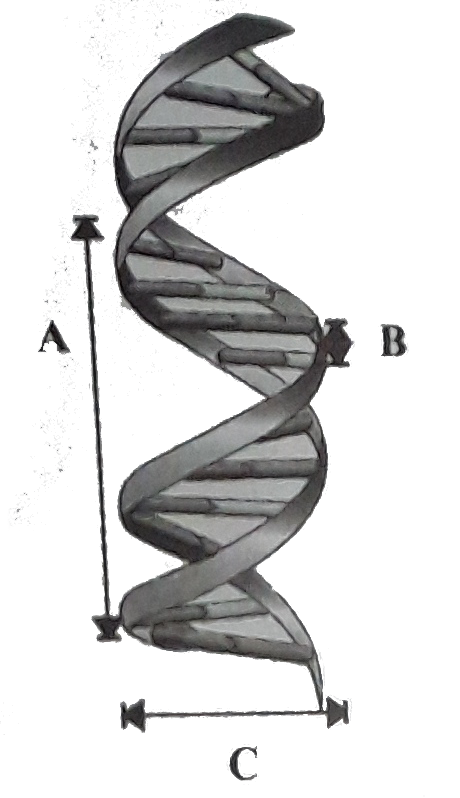Define nucleic acid. Describe the structure of DNA model proposed by Watson and Crick.
Step-by-Step Solution:
1. Definition of Nucleic Acid:
Nucleic acids are long chain-like molecules that are essential for all forms of life. They are composed of smaller units called nucleotides. Each nucleotide consists of three components: a sugar molecule, a phosphate group, and a nitrogenous base. The sequence of these nucleotides forms the genetic information in organisms.
2. Types of Nucleic Acids:
There are two main types of nucleic acids:
- DNA (Deoxyribonucleic Acid): Contains deoxyribose sugar, is double-stranded, and carries the genetic blueprint of an organism.
- RNA (Ribonucleic Acid): Contains ribose sugar, is usually single-stranded, and plays various roles in protein synthesis and gene expression.
3. Structure of DNA as Proposed by Watson and Crick:
- Double Helix Model: Watson and Crick proposed that DNA has a double helical structure. This means that it consists of two strands that twist around each other.
- Backbone Composition: The backbone of the DNA molecule is made up of alternating sugar and phosphate groups.
- Base Pairing: The nitrogenous bases (adenine, thymine, guanine, and cytosine) are attached to the sugar molecules. The bases pair specifically: adenine pairs with thymine (via two hydrogen bonds), and guanine pairs with cytosine (via three hydrogen bonds).
- Grooves: The structure features major and minor grooves, which are the spaces between the two strands where proteins can bind.
- Dimensions: The diameter of the DNA double helix is approximately 20 angstroms (2 nanometers). The distance between adjacent base pairs is about 0.34 nanometers, and one complete turn of the helix measures about 3.4 nanometers.
4. Conclusion:
The Watson and Crick model of DNA provides a comprehensive understanding of its structure, which is crucial for its function in heredity and cellular processes.
---
Nucleic acids are long chain-like molecules that are essential for all forms of life. They are composed of smaller units called nucleotides. Each nucleotide consists of three components: a sugar molecule, a phosphate group, and a nitrogenous base. The sequence of these nucleotides forms the genetic information in organisms.
There are two main types of nucleic acids:
- DNA (Deoxyribonucleic Acid): Contains deoxyribose sugar, is double-stranded, and carries the genetic blueprint of an organism.
- RNA (Ribonucleic Acid): Contains ribose sugar, is usually single-stranded, and plays various roles in protein synthesis and gene expression.
- Double Helix Model: Watson and Crick proposed that DNA has a double helical structure. This means that it consists of two strands that twist around each other.
- Backbone Composition: The backbone of the DNA molecule is made up of alternating sugar and phosphate groups.
- Base Pairing: The nitrogenous bases (adenine, thymine, guanine, and cytosine) are attached to the sugar molecules. The bases pair specifically: adenine pairs with thymine (via two hydrogen bonds), and guanine pairs with cytosine (via three hydrogen bonds).
- Grooves: The structure features major and minor grooves, which are the spaces between the two strands where proteins can bind.
- Dimensions: The diameter of the DNA double helix is approximately 20 angstroms (2 nanometers). The distance between adjacent base pairs is about 0.34 nanometers, and one complete turn of the helix measures about 3.4 nanometers.
The Watson and Crick model of DNA provides a comprehensive understanding of its structure, which is crucial for its function in heredity and cellular processes.
Topper's Solved these Questions
- BIOMOLECULESBOOK - ICSECHAPTER - BIOMOLECULESEXERCISE - TEST YOUR PROGRESS (SHORT/LONG ANSWER TYPE QUESTIONS)
1 Videos
- BIOMOLECULESBOOK - ICSECHAPTER - BIOMOLECULESEXERCISE - TEST YOUR PROGRESS (HIGHER ORDER THINKING SKILLS QUESTIONS)
8 Videos
- BIOMOLECULESBOOK - ICSECHAPTER - BIOMOLECULESEXERCISE - TEST YOUR PROGRESS (VERY SHORT ANSWER TYPE QUESTIONS)
77 Videos
- BIOLOGY ISC SAMPLE QUESTION PAPER 2019BOOK - ICSECHAPTER - BIOLOGY ISC SAMPLE QUESTION PAPER 2019EXERCISE - PART-II (SECTION -C)
6 Videos
- BODY FLUIDS AND CIRCULATIONBOOK - ICSECHAPTER - BODY FLUIDS AND CIRCULATIONEXERCISE - DIFFRENTIATE BETWEEN
13 Videos
Similar Questions
Knowledge Check
Given figure represents the DNA double helix model as proposed by Waston and Crick (1953). Select the option that shown correct measurements of A, B and C.
 AA-3.4nm,B-0.34 nm, C-2 nmBA-3.4nm, B-3.4nm,C-20nmCA-3.4Å,B-3.4Å, C-20ÅDA-34 Å,B-3.4Å , C-2Å
AA-3.4nm,B-0.34 nm, C-2 nmBA-3.4nm, B-3.4nm,C-20nmCA-3.4Å,B-3.4Å, C-20ÅDA-34 Å,B-3.4Å , C-2ÅIn the double helix model of DNA as proposed by J. D. Watson and F.H.C. Crick, each base pair is how far from the next base pair?
A0.034 nmB0.34 nmC3.4 nmD34 nm
Double helix model of DNA which was proposed by watson and crick was of-
View SolutionWhat are the functions of nucleic acids ? What are the structures of sugar molecules present in DNA and RNA.
View SolutionThe helical model for DNA given by Watson and Crick was
View SolutionThe double helix model of DNA was proposed by
View SolutionNucleic acid exhibit secondary structure. Describe through Watson-Crick model.
View SolutionCorrect and rewrite the statement by changing the biological term that is underlined for each statement: The theory of Inheritance of Acquired Characters was proposed by Watson and Crick.
View Solution
